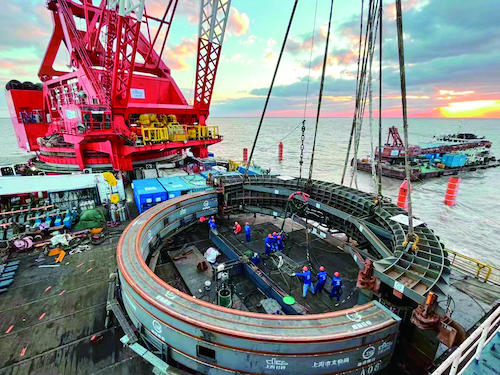A historic breakthrough in China's underwater archaeology was witnessed in the waters of Hengsha at the mouth of the Yangtze River: The semi-circular caisson made up of 22 giant curved beams, manufactured by the Shanghai Electric Nuclear Power Group Co., Ltd., was loaded with the largest wooden shipwreck ever found, the No.2 ancient ship in the Yangtze River Estuary. After more than 4 hours of lifting, the ancient ship was successfully salvaged at 0:40 a.m. on November 21.
The salvage work adopts the pioneering “curved beam non-contact overall migration technology for cultural relics”. After the first batch of components arrived at the salvage site on August 17, it took only 95 days to assemble the caisson, which is about 50 meters long, 20 meters wide and 10 meters high. The assembly is smooth because the curved beams manufactured by the Nuclear Power Group successfully overcame the submarine sediment erosion and hydrological conditions. On November 20, the nearly 10,000-ton caisson loaded with the ancient ship, sediment and seawater was steadily lifted by the salvage vessel named “Fenli” at a speed of about 4 meters per hour. At 00:40 on November 21, the mast of the ancient ship resurfaced.
The Nuclear Power Group started to develop the isometric model for the salvage of the ancient wreck as early as July 2021, and successfully completed the isometric model test on January 12 this year. On March 25, despite the force majeure events such as the COVID-19, the Nuclear Power Group organized manufacturing and processing personnel to efficiently advance the manufacturing of the final product against the clock. On July 17, the first 4 longitudinal beams were delivered; on August 17, the first batch of core devices including the launcher and 4 curved beams arrived at the salvage site; and on October 18, the delivery of all curved beams was completed.
In 8 months, the Nuclear Power Group produced a total of 2,600 tons of equipment and successfully applied the large curved beam technology to the field of archaeology and heritage protection, which demonstrated not only the Group’s strength in advanced assembly and manufacturing, but also its development strategy for “cross-border integration and collaborative development”.






 Shanghai PNS registry No. 31010102007087
Shanghai PNS registry No. 31010102007087